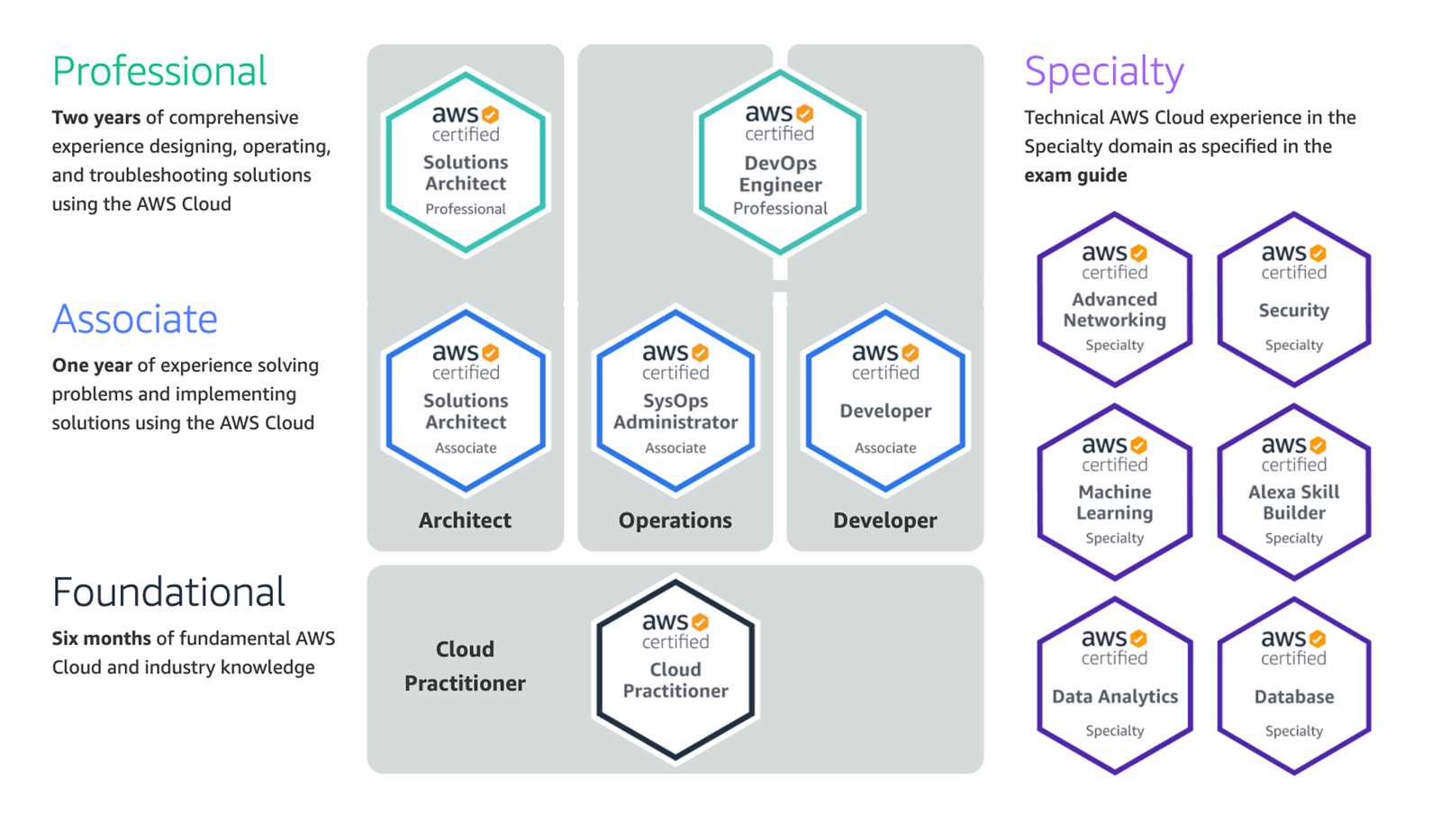
Achieving cloud certification can be a transformative step in your career, especially in a rapidly evolving technology landscape. This process involves mastering a range of foundational concepts that are essential for working with cloud-based systems. Proper preparation is key to understanding the core principles and successfully navigating the certification exam.
In this guide, we focus on providing the right tools to help you succeed. Whether you are new to the cloud or have some experience, a structured approach to studying can significantly improve your chances of passing the exam. By reviewing essential topics, practicing with relevant questions, and applying your knowledge, you will be equipped to handle various challenges on test day.
Throughout this article, we will explore different strategies and resources that can enhance your readiness. From common exam questions to critical concepts, our goal is to ensure you approach your study plan with confidence and clarity.
Essential Concepts for Cloud Practitioner Exam
To successfully navigate the certification exam, it’s crucial to understand the key principles that form the foundation of cloud computing. These concepts will be at the core of most questions and scenarios you’ll face. The focus is on understanding how cloud technologies operate, the benefits they offer, and how they are utilized in various environments.
Below are some of the most important areas to concentrate on when preparing for the test:
- Cloud Computing Models – Grasping the differences between public, private, and hybrid clouds is essential. Understand how each model is implemented and the advantages they offer.
- Core AWS Services – Familiarize yourself with the most commonly used AWS services, such as compute, storage, and networking. Key services like EC2, S3, and VPC play a significant role in cloud environments.
- Cloud Economics – Learn about pricing structures, cost management tools, and the benefits of the pay-as-you-go model. Understand AWS billing methods and how to estimate costs effectively.
- Security Fundamentals – Cloud security is a priority, so understanding the shared responsibility model, data encryption, and access control mechanisms is critical.
- Compliance and Governance – Be aware of global compliance standards, data privacy regulations, and how AWS helps customers meet various legal and regulatory requirements.
Each of these areas plays a key role in the exam, so focusing on mastering them will give you a solid foundation to approach the test with confidence. By reviewing these core concepts, you will not only prepare for the exam but also gain a deeper understanding of cloud technologies that can be applied in real-world scenarios.
Key Topics to Study for the Exam
When preparing for the cloud certification test, focusing on the most critical topics will ensure that you cover all essential areas. These topics are fundamental to understanding cloud principles, services, and their practical applications. Mastering these concepts will give you a clear advantage during the exam.
Below are the key subjects to prioritize during your preparation:
- Cloud Concepts and Models – Study the different deployment models, including public, private, and hybrid clouds. Understand their benefits and use cases.
- AWS Global Infrastructure – Familiarize yourself with the AWS global network, regions, availability zones, and edge locations.
- Compute Services – Focus on key services like EC2 (Elastic Compute Cloud) and its use cases. Understand how to select the right instance types for various applications.
- Storage Options – Learn about the different storage solutions AWS offers, such as S3, EBS, and Glacier. Understand when and why to use each service.
- Networking Basics – Study the core networking concepts like VPC (Virtual Private Cloud), subnets, route tables, and security groups. These are essential for configuring and securing cloud environments.
- Security and Identity Management – Understand how AWS handles identity and access management (IAM), encryption, and security best practices. The shared responsibility model is a key concept to grasp here.
- Cost and Billing – Be familiar with the pricing models AWS uses, including the pay-as-you-go system, and how to estimate and manage costs effectively with tools like the AWS Pricing Calculator.
- Compliance and Governance – Learn about the compliance frameworks AWS supports, such as GDPR and HIPAA, and how to use AWS tools to maintain regulatory compliance.
By concentrating on these key topics, you’ll be able to build a strong understanding of the services and concepts that are frequently tested. This targeted approach will help you approach the exam with clarity and confidence.
Understanding AWS Cloud Foundations

Grasping the basic structure and core elements of cloud computing is essential for any cloud certification exam. The foundational knowledge covers the key services, architecture, and deployment models that shape the cloud landscape. A clear understanding of these building blocks is crucial for navigating and utilizing the platform effectively.
Core Cloud Concepts
Cloud computing relies on key concepts such as scalability, elasticity, and on-demand access to resources. Understanding these will help you determine when and why to use cloud services over traditional IT solutions. The ability to scale services up or down according to demand, while paying only for what is used, is a major benefit of cloud environments. Familiarity with these principles lays the groundwork for exploring more advanced topics.
AWS Services Overview
AWS provides a broad range of services, from computing power to storage, networking, and security. Key services like EC2, S3, and Lambda are the building blocks of any AWS environment. Knowing how each service works and their typical use cases will help you understand how to design efficient cloud architectures. Additionally, learning how these services integrate with each other will enhance your ability to solve real-world cloud challenges.
Tips for Effective Exam Preparation
Preparing for a cloud certification exam requires a strategic approach that balances theory with hands-on practice. To succeed, it’s important to have a clear study plan, stay organized, and make use of the right resources. By following these tips, you can maximize your chances of performing well on the exam.
- Create a Study Schedule – Break down your study material into manageable chunks and set a timeline for each topic. Stick to a consistent study routine to stay on track.
- Focus on Core Concepts – Concentrate on the fundamental topics that form the basis of cloud services and infrastructure. Make sure you fully understand key concepts before moving on to advanced ones.
- Use Practice Tests – Take advantage of practice exams to familiarize yourself with the question format and identify areas that need more attention. Simulate real exam conditions to build confidence.
- Review Official Documentation – AWS offers comprehensive documentation for its services. Reviewing this material will help you understand how AWS tools work and prepare you for questions based on real-world scenarios.
- Study with Interactive Labs – Hands-on practice is crucial for understanding cloud environments. Use labs or sandbox environments to get practical experience with key AWS services.
- Join Online Communities – Participate in forums, discussion groups, and study sessions to exchange tips, resources, and insights with fellow exam candidates. Sharing experiences can help you gain new perspectives.
- Track Your Progress – Regularly assess your understanding of the material. Identify weak areas and revisit them until you feel confident.
By following these strategies and maintaining a disciplined approach, you’ll be well-equipped to tackle the exam with confidence and achieve a successful outcome.
Common Exam Pitfalls to Avoid
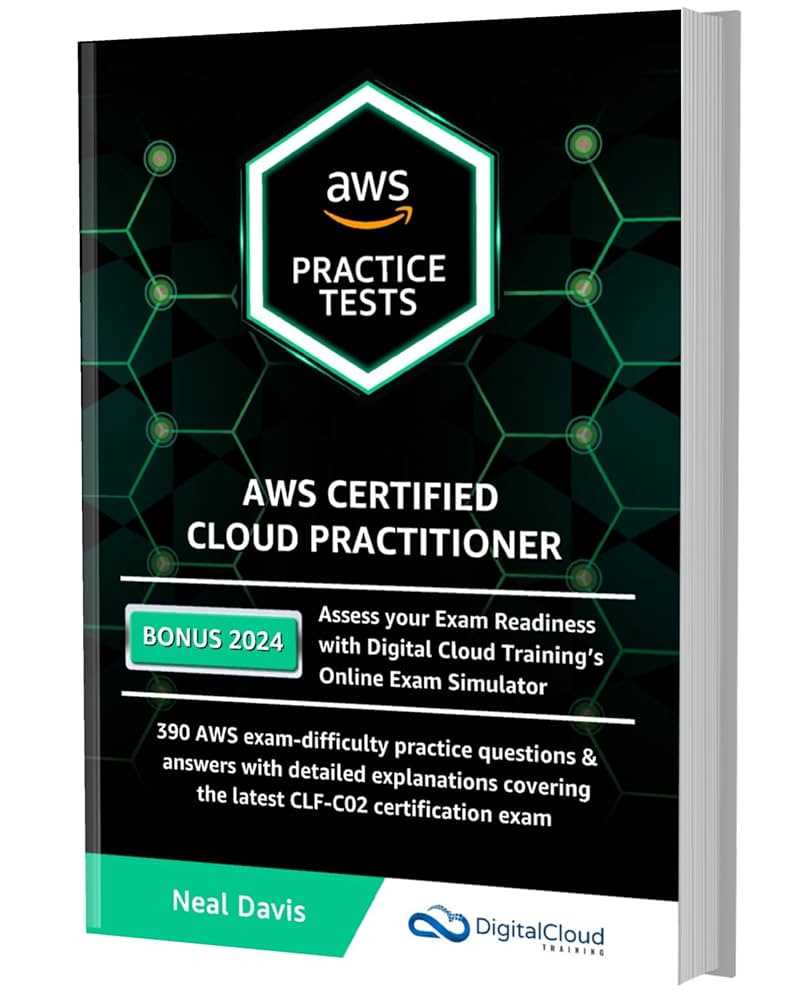
While preparing for a certification exam, many candidates make common mistakes that can negatively impact their performance. Recognizing and avoiding these pitfalls is key to ensuring success. By understanding what to watch out for, you can improve your focus and approach, ultimately boosting your chances of passing the exam.
- Overlooking Key Concepts – It’s easy to get caught up in mastering advanced topics, but neglecting the fundamental concepts can hurt your chances. Ensure you have a strong grasp of core cloud principles before diving into more complex material.
- Relying Too Much on Memorization – Memorizing answers to practice questions without understanding the underlying principles is a common mistake. Focus on understanding how and why services work, rather than just recalling facts.
- Neglecting Hands-On Practice – While studying theory is important, real-world experience with AWS tools is essential. Avoid relying solely on textbooks and practice tests; ensure you spend time working with the actual services in a hands-on environment.
- Skipping Official Documentation – Many candidates overlook the value of official resources like AWS documentation. These materials are a key part of exam preparation and provide insight into how services work in practice.
- Ignoring Time Management – Poor time management during the exam can lead to incomplete answers or rushed decisions. Practice managing your time effectively so you can allocate the right amount of attention to each question.
- Not Reviewing Mistakes – Simply taking practice tests without reviewing the wrong answers doesn’t help improve your understanding. Always take the time to learn from your mistakes and understand why certain answers are correct or incorrect.
- Assuming All Questions are Equal – Avoid spending too much time on one question. Some questions are designed to be more challenging, but they don’t carry more weight. Balance your time across all questions to ensure you address every part of the exam.
By staying aware of these pitfalls and adjusting your study habits accordingly, you can approach the exam with greater confidence and a clearer focus on what truly matters.
Overview of AWS Services and Solutions
Understanding the range of services and solutions offered by AWS is crucial for navigating cloud computing environments. AWS provides a comprehensive suite of tools that cater to various business needs, from infrastructure and computing to storage and machine learning. Familiarizing yourself with these services will help you understand their practical applications and how they integrate to form a complete cloud solution.
AWS offers an extensive array of services that span several categories, including computing, networking, storage, databases, analytics, and security. Each service is designed to support different aspects of cloud operations, enabling users to build scalable and cost-efficient systems. By leveraging these services, businesses can optimize their infrastructure, enhance performance, and ensure security in the cloud.
Some of the most widely used AWS services include:
- Compute Services – EC2 (Elastic Compute Cloud) provides scalable virtual servers, while AWS Lambda offers serverless computing options for event-driven applications.
- Storage Solutions – S3 (Simple Storage Service) is a reliable object storage service, and EBS (Elastic Block Store) offers persistent storage for EC2 instances.
- Networking – VPC (Virtual Private Cloud) allows users to create isolated networks, while Route 53 provides scalable domain name services (DNS).
- Database Services – RDS (Relational Database Service) supports various databases, and DynamoDB offers a fast NoSQL database service for highly available applications.
- Security and Identity – IAM (Identity and Access Management) controls user access, while AWS Shield and WAF (Web Application Firewall) help protect applications from malicious threats.
By understanding these services, you can gain deeper insights into how AWS empowers organizations to solve real-world challenges with cloud-based solutions. This knowledge will also assist in preparing for the certification exam, as it covers many of the essential topics tested during the assessment.
Importance of Cloud Security in AWS
Ensuring the security of cloud environments is crucial for organizations that rely on AWS for their infrastructure. As businesses store sensitive data and run mission-critical applications on the cloud, protecting this information becomes a top priority. AWS provides various security measures, but the responsibility is shared between AWS and the user, making it essential to understand the core principles and best practices for securing your cloud resources.
Shared Responsibility Model
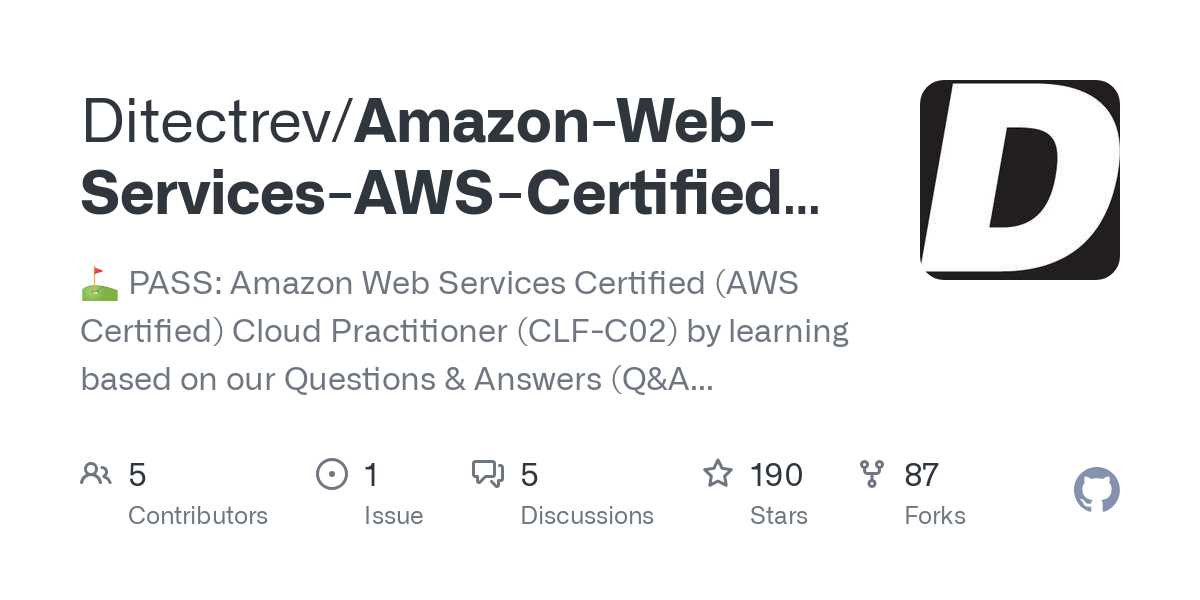
A key aspect of cloud security is the shared responsibility model, which outlines the division of security tasks between AWS and the customer. AWS is responsible for the security *of* the cloud, including physical infrastructure, while customers are responsible for the security *in* the cloud, which covers data, access management, and application security. Understanding this model is fundamental to implementing effective security strategies.
Key Security Measures in AWS
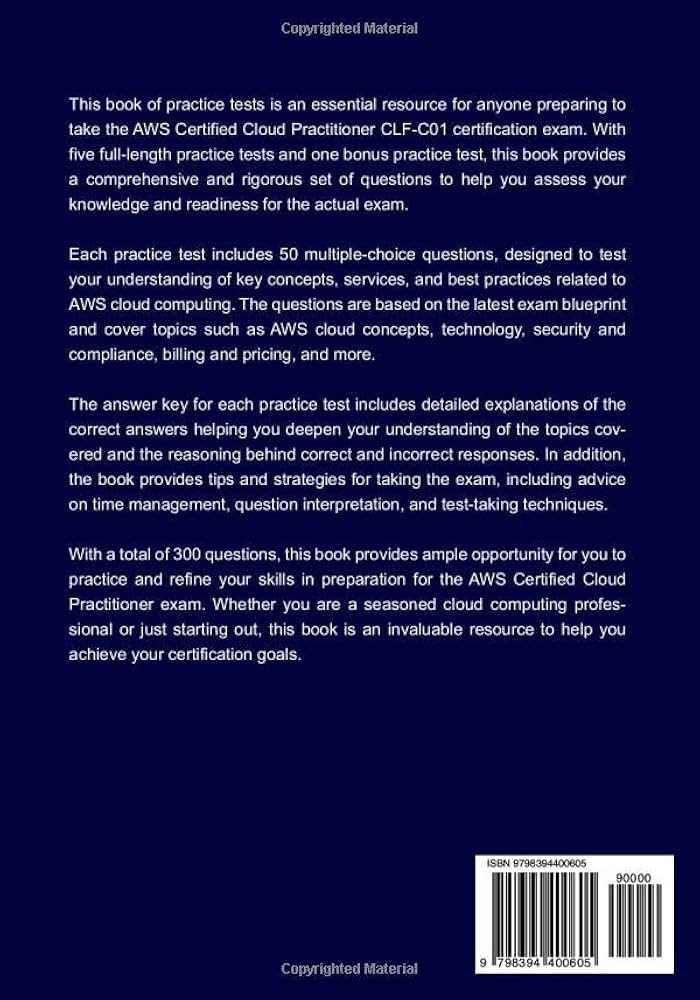
AWS offers a variety of tools and services to enhance the security of your environment. Some of the most critical security measures include:
- Identity and Access Management (IAM) – Controls user access to AWS resources by defining permissions and roles. Proper configuration ensures that only authorized users can access sensitive data and services.
- Encryption – AWS provides several encryption options, such as SSL/TLS for data in transit and AES-256 for data at rest, helping protect your information from unauthorized access.
- Network Security – Tools like Virtual Private Cloud (VPC), security groups, and AWS Shield help secure network traffic, manage firewall settings, and prevent DDoS attacks.
- Monitoring and Auditing – Services like CloudTrail and CloudWatch provide logging and monitoring capabilities, allowing you to track access, detect potential threats, and maintain compliance with security policies.
- Compliance – AWS offers certifications and compliance programs, such as SOC 2, PCI-DSS, and GDPR, ensuring that your infrastructure meets legal and regulatory requirements for data protection.
By prioritizing cloud security and leveraging the tools AWS offers, organizations can safeguard their infrastructure and meet industry standards for protecting sensitive data. Understanding the security measures available within AWS is vital not only for keeping systems secure but also for passing certification exams that assess your knowledge of cloud security best practices.
Exam Question Types You Should Expect
When preparing for a cloud certification exam, understanding the different types of questions you may encounter is essential for effective study. The format of the questions can vary, testing not only your knowledge but also your ability to apply concepts in practical scenarios. By familiarizing yourself with the question types, you can tailor your study approach and improve your performance on exam day.
Typically, cloud certification exams will include a variety of question formats, each designed to assess different aspects of your understanding. These may include:
- Multiple-Choice Questions – The most common format, where you are presented with a question and four possible answers. Only one answer is correct, but the options may appear similar, making it important to read each carefully.
- Multiple-Response Questions – These questions ask you to select more than one correct answer. Be sure to choose all the answers that apply, as missing one could result in an incorrect response.
- Scenario-Based Questions – These questions describe a real-world situation and ask you to choose the best solution based on the provided information. They often require you to apply your knowledge to practical use cases.
- Drag-and-Drop Questions – You may need to match items from one column to another, such as services to their respective features or benefits. This format tests your understanding of how different components fit together in the cloud environment.
- Fill-in-the-Blank Questions – These questions present a statement with missing information. You will need to provide the correct term or concept that completes the statement, testing your recall and knowledge of specific details.
Being prepared for these various question types allows you to approach the exam with confidence. Take time to practice each format, as understanding how to tackle different types of questions is just as important as knowing the content itself. With consistent preparation and a clear understanding of the exam structure, you will be ready to succeed.
Building a Study Plan for the Exam
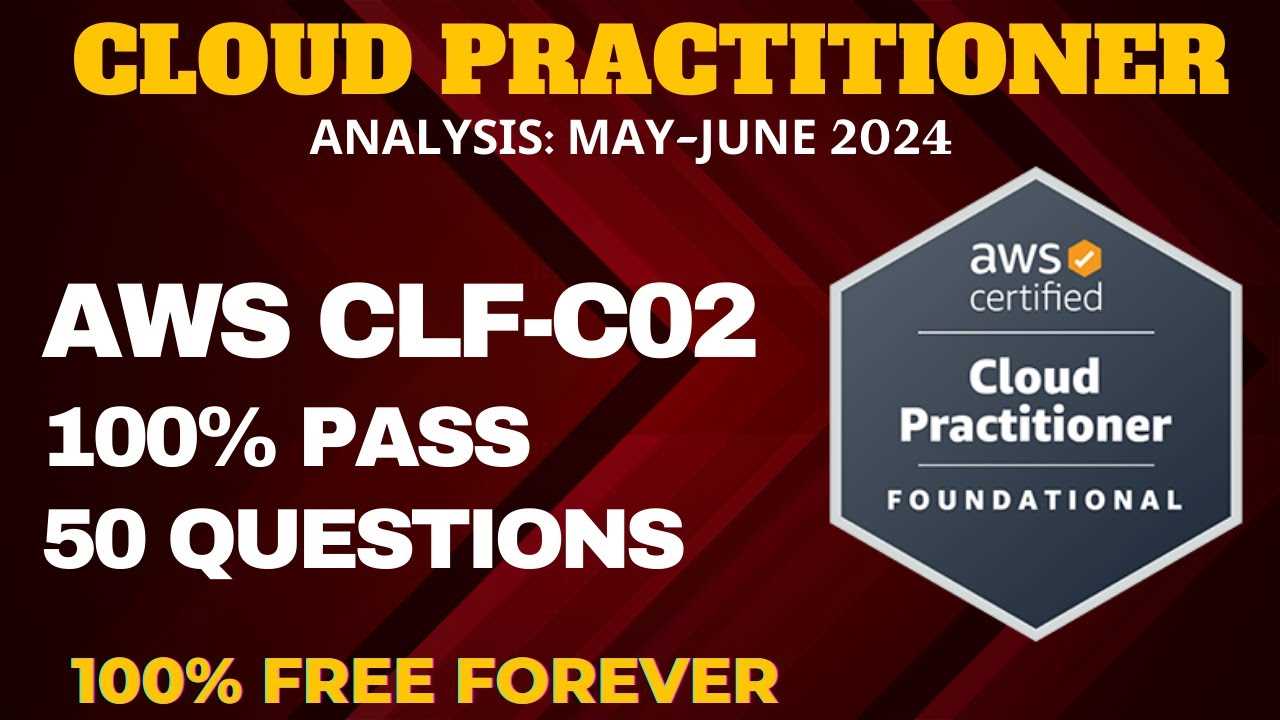
Creating a well-structured study plan is essential for success when preparing for any certification exam. It ensures that you cover all necessary topics in a systematic way while giving yourself enough time to review and reinforce your understanding. A solid plan also helps you stay focused, manage your time effectively, and reduce anxiety as the exam approaches.
To build an effective study plan, start by outlining the key topics that will be covered in the exam. Break these topics into manageable sections, and allocate specific time slots for each one. This helps you avoid feeling overwhelmed and ensures that you dedicate adequate time to each subject.
Here are some important steps to follow when creating your study plan:
- Assess Your Current Knowledge – Begin by evaluating your understanding of the key concepts. Identify areas where you feel confident and others that may require more attention.
- Set Realistic Goals – Break down your preparation into smaller, achievable goals. For example, aim to complete a certain number of practice questions each day or master specific topics within a set time frame.
- Schedule Study Sessions – Allocate time each day for focused study sessions. Consistency is key, so aim for regular, shorter sessions rather than cramming large amounts of material in one sitting.
- Include Review Time – Set aside time for revision and practice tests. Reviewing your progress will help reinforce the material and identify areas that need improvement.
- Utilize Different Resources – Use a variety of study materials such as online courses, books, and practice exams. Different formats can help reinforce your learning and provide a deeper understanding of the content.
By following a structured approach and staying disciplined, you can maximize your study efficiency and boost your chances of passing the exam. A well-organized study plan will help you stay on track, measure your progress, and ensure you’re fully prepared when it’s time to take the test.
Frequently Asked Questions by Candidates
When preparing for a cloud certification exam, many candidates have common questions about the process, the content, and the best approaches to studying. It’s natural to seek clarity before diving into the preparation journey. Addressing these frequently asked questions can help alleviate concerns and guide you in the right direction to ensure you’re well-prepared.
General Exam Information
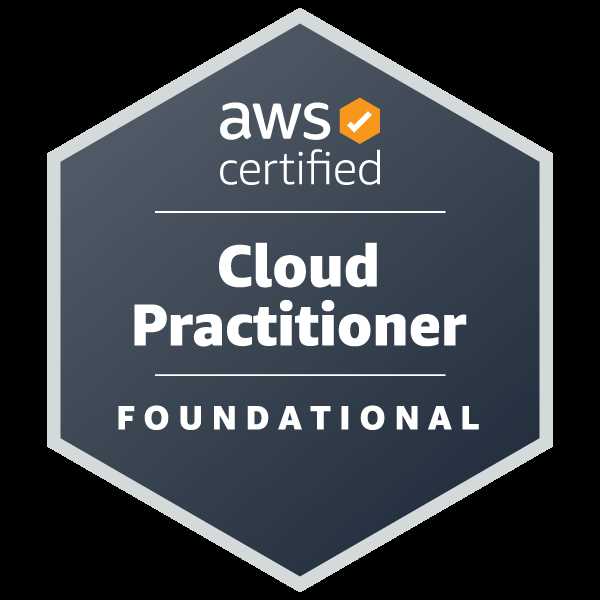
Many candidates wonder about the specifics of the exam itself, such as its format, duration, and required passing score. Some of the most common queries include:
- What is the format of the exam? – The exam typically consists of multiple-choice and multiple-response questions. It may also include scenario-based questions to assess your practical understanding of cloud concepts.
- How long is the exam? – The duration of the exam is usually around 90 minutes. You will be given a set amount of time to answer all the questions, so time management is key.
- What is the passing score? – The passing score generally varies, but most exams require a minimum score of around 70%. It’s important to review the official guidelines for the exact passing criteria.
- Can I retake the exam if I fail? – Yes, candidates who do not pass the exam can retake it. However, you must wait a certain period (usually 14 days) before attempting it again.
Study Tips and Resources
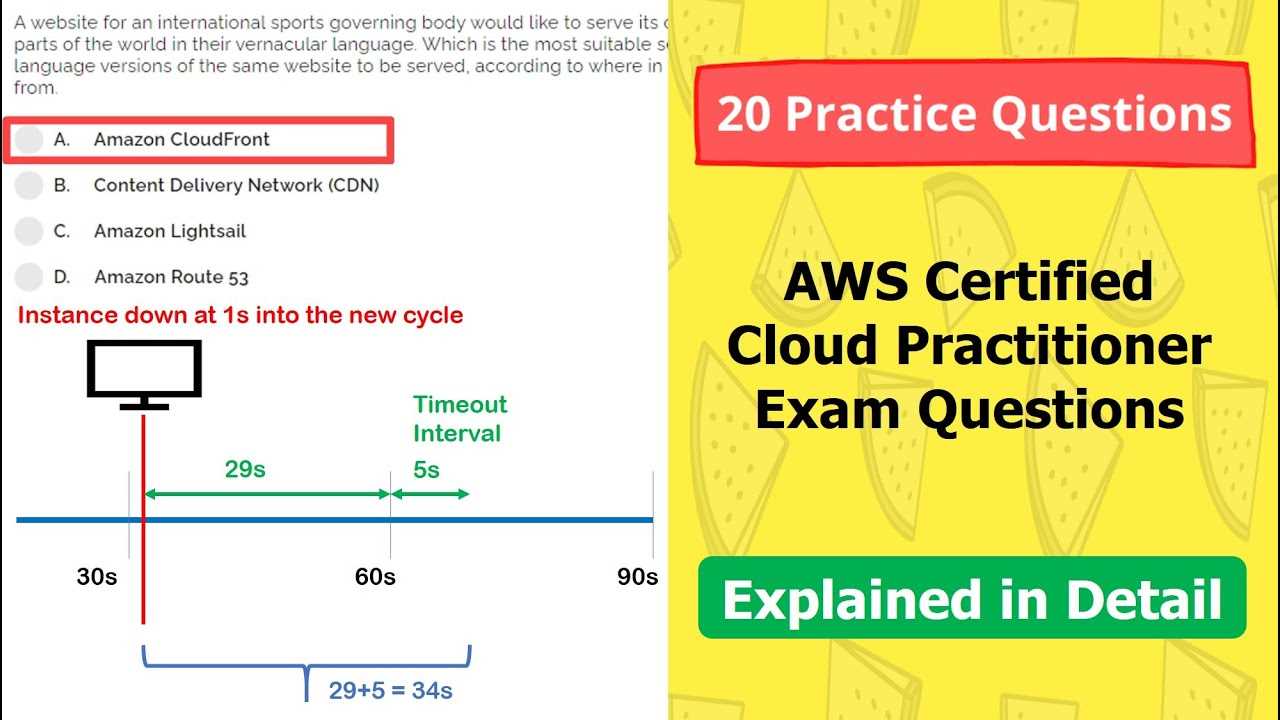
Another common area of concern is how to effectively prepare for the exam. Many candidates ask about study resources, tips, and strategies to improve their chances of success:
- What study materials should I use? – It’s recommended to use a combination of official AWS study guides, online courses, and practice exams. These resources are designed to cover the key topics and question formats you’ll encounter on the exam.
- How much time should I spend studying? – The amount of time varies depending on your prior knowledge, but generally, a few weeks to a couple of months of consistent study will prepare you adequately. Aim for a balanced study schedule with regular review sessions.
- Are practice exams useful? – Yes, practice exams are a great way to assess your readiness. They simulate the actual exam environment and help you become familiar with the types of questions asked. Taking practice tests also highlights areas that need further study.
- What if I don’t have hands-on experience? – While hands-on experience can be helpful, many candidates successfully pass the exam by studying the theoretical concepts and reviewing case studies. However, some practical knowledge of AWS services can be beneficial.
By addressing these frequently asked questions, you can gain a better understanding of the exam process and how to approach your preparation. Make sure to stay organized, focus on key topics, and utilize various resources to ensure you feel confident on exam day.
Time Management Strategies During the Exam
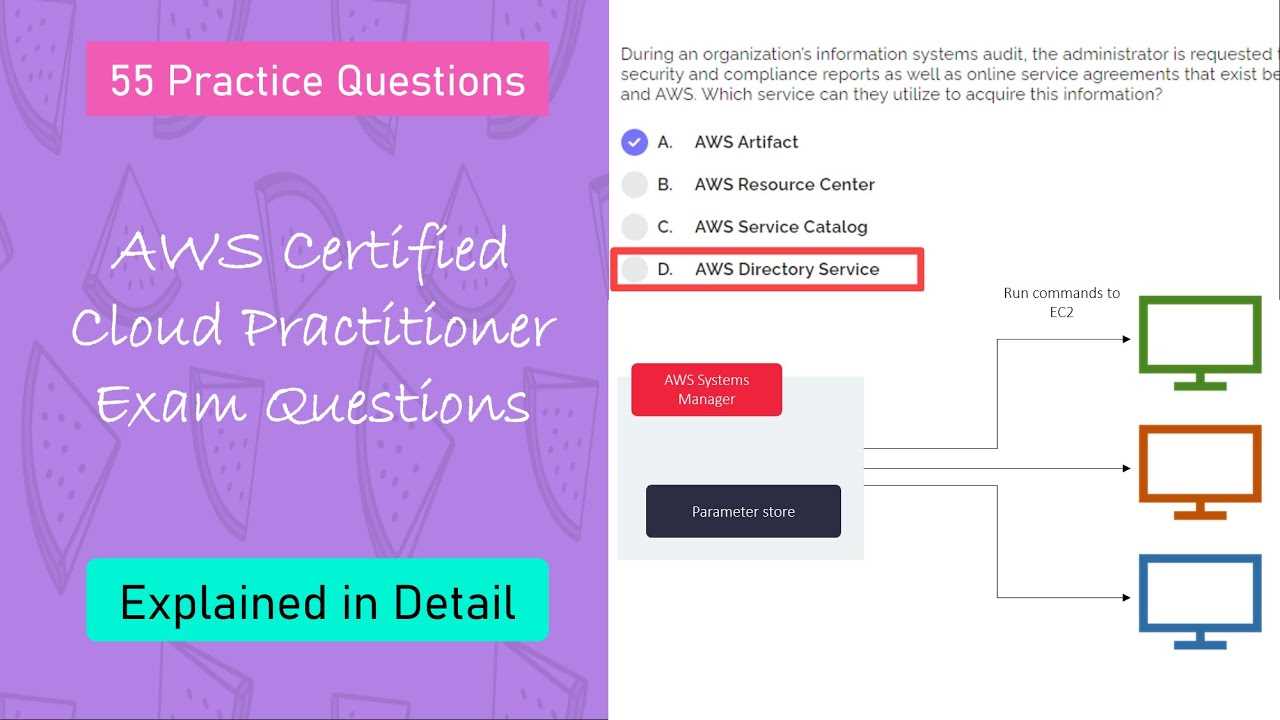
Effective time management is a crucial skill when taking any exam, especially one with a strict time limit. Properly allocating your time ensures you can complete all questions while giving yourself enough time to review your answers. By planning ahead and using strategic techniques, you can avoid feeling rushed and maximize your performance during the test.
Here are some practical strategies to manage your time effectively during the exam:
| Strategy | Tip |
|---|---|
| Know the Exam Duration | Familiarize yourself with the total exam time and the number of questions. This will help you set time limits for each section. |
| Allocate Time per Question | Divide the total time by the number of questions to understand how much time you should spend on each one. Adjust for more complex questions. |
| Skip and Return | If you’re stuck on a question, move on to the next one and return later. This prevents wasting time on questions you might find difficult. |
| Track Time Progress | Periodically glance at the clock to monitor your pace. Aim to be about halfway through the exam by the halfway point of your time. |
| Use the Process of Elimination | If unsure about an answer, eliminate obviously wrong options first. This increases your chances of selecting the correct one, saving you time. |
| Leave Time for Review | Ensure you leave some time at the end to review your answers. This is essential for spotting any errors or missed questions. |
By implementing these strategies, you can optimize your exam experience. Staying calm, focused, and mindful of your time will help you navigate the test more efficiently and confidently. Remember, time management isn’t just about speeding through questions; it’s about making thoughtful decisions that lead to better performance.
How to Use AWS Free Tier for Practice
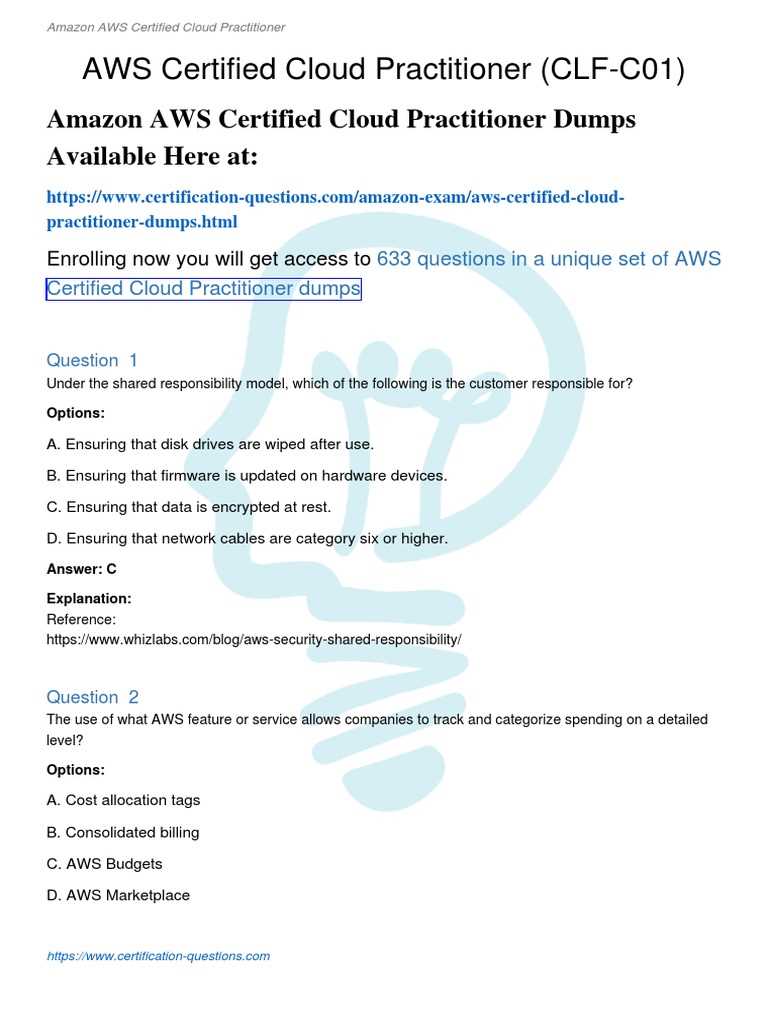
The AWS Free Tier provides an excellent opportunity for individuals preparing for cloud certification exams to gain hands-on experience without incurring additional costs. By leveraging free resources, you can familiarize yourself with AWS services, build and test various cloud-based solutions, and deepen your understanding of the platform’s core offerings. This section will guide you on how to use the AWS Free Tier effectively for your exam preparation.
Here are some practical ways to make the most out of the AWS Free Tier:
| Tip | Description |
|---|---|
| Explore Core Services | Use the Free Tier to practice with essential AWS services like EC2, S3, RDS, and Lambda. These services are frequently covered in the exam, so gaining practical experience with them is invaluable. |
| Create a Test Environment | Set up a small test environment using Free Tier resources to simulate real-world cloud scenarios. This will help you understand how various services interact and support your learning. |
| Experiment with Configurations | Experiment with different configurations and architectures. For instance, you can try setting up a web server on EC2 or configuring an S3 bucket for static website hosting. |
| Monitor Usage and Cost | Track your usage through the AWS billing dashboard to ensure you are staying within the Free Tier limits. Understanding cost management and resource monitoring is key for the exam. |
| Follow Tutorials | AWS offers various free tutorials that align with the services covered in the Free Tier. These tutorials can guide you step by step in creating and managing cloud environments. |
| Use Hands-on Labs | Many learning platforms provide hands-on labs that allow you to use AWS Free Tier services. This provides you with practical experience in a controlled, real-world context. |
Using the AWS Free Tier effectively helps build confidence and hands-on skills, allowing you to gain a deeper understanding of AWS services. By applying what you learn in a real-world environment, you’ll be better prepared for your certification exam and have the ability to manage cloud infrastructure with ease.
Understanding AWS Pricing and Billing
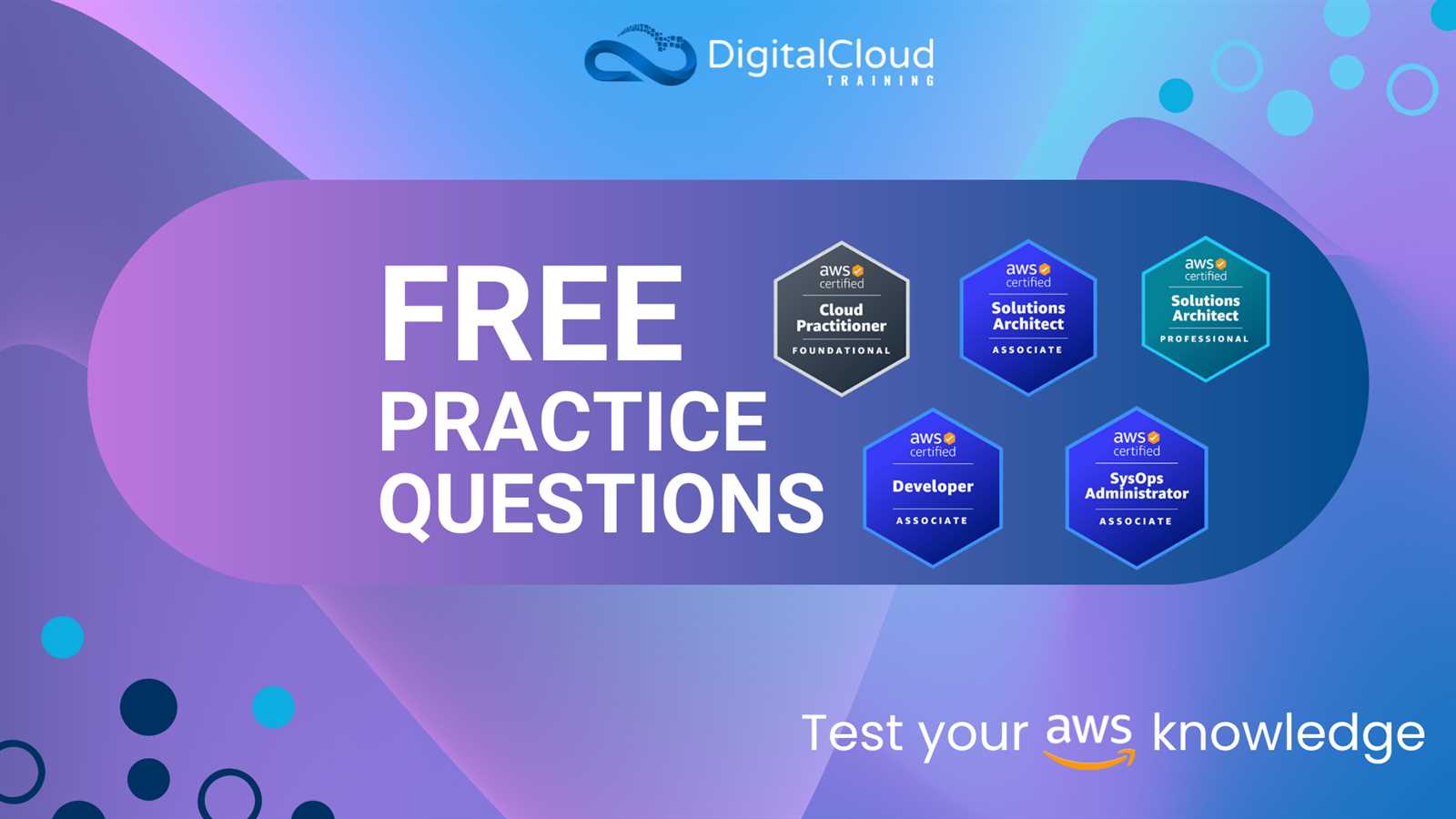
One of the key concepts to understand when preparing for a cloud certification exam is how cloud services are priced and billed. AWS operates on a pay-as-you-go model, meaning you are charged based on the resources and services you use. However, there are several factors that can influence costs, including service types, usage volume, and the region where resources are deployed. Gaining a solid understanding of AWS pricing and billing is crucial for both managing costs effectively and for exam success.
AWS provides various pricing models and tools to help users optimize their costs while using cloud resources. Below are some of the most important components to familiarize yourself with:
- On-Demand Pricing: This model allows users to pay for resources as they use them, without any long-term commitments. It’s ideal for applications with unpredictable workloads.
- Reserved Instances: With Reserved Instances, users commit to using specific resources for a longer period (typically 1 or 3 years), in exchange for a lower rate. This is useful for predictable workloads that require consistent capacity.
- Spot Instances: Spot Instances let users bid for unused capacity at a lower cost. These are suitable for flexible and fault-tolerant applications, as the availability of Spot Instances can change.
- Free Tier: AWS offers a free tier with limited usage of select services for new users. It’s a great option for experimentation and learning, without incurring costs.
- Pricing Calculator: The AWS Pricing Calculator helps estimate costs based on your projected usage of different services. It can be a valuable tool when planning budgets for cloud projects.
- Cost Explorer: AWS provides Cost Explorer, a tool that enables users to analyze their spending patterns and optimize their use of services to reduce costs.
By understanding these pricing models and tools, you can avoid unexpected costs and manage your cloud resources more effectively. Additionally, familiarity with pricing structures is a common topic on certification exams, as cost management is a crucial aspect of cloud adoption and operation.
Reviewing Sample AWS Cloud Practitioner Questions
One of the best ways to prepare for any certification exam is by practicing with sample questions. By reviewing potential questions for the cloud certification, you can become familiar with the types of topics covered and the format of the exam. This practice helps you identify areas where you need more study, and it builds confidence in tackling real exam questions. Below, we review some example questions to help guide your preparation and provide insights into what to expect.
Example Question 1: Understanding Cloud Benefits
This question type typically assesses your knowledge of the advantages of using cloud services. The question may ask about cost savings, flexibility, or scalability that cloud computing offers compared to traditional on-premises infrastructure.
- Question: What is one of the main benefits of using cloud services over traditional IT infrastructure?
- Options:
- Increased hardware costs
- Lower flexibility in resource allocation
- On-demand scalability
- Decreased security options
- Correct Answer: On-demand scalability
Explanation: Cloud services allow organizations to scale resources up or down as needed, providing significant flexibility and efficiency in managing costs and resources.
Example Question 2: Identifying Key AWS Services
- Question: Which AWS service is primarily used for object storage?
- Options:
- Amazon EC2
- Amazon S3
- Amazon RDS
- Amazon Lambda
- Correct Answer: Amazon S3
Explanation: Amazon S3 (Simple Storage Service) is designed to store and retrieve any amount of data at any time, making it ideal for object storage.
How to Approach These Questions
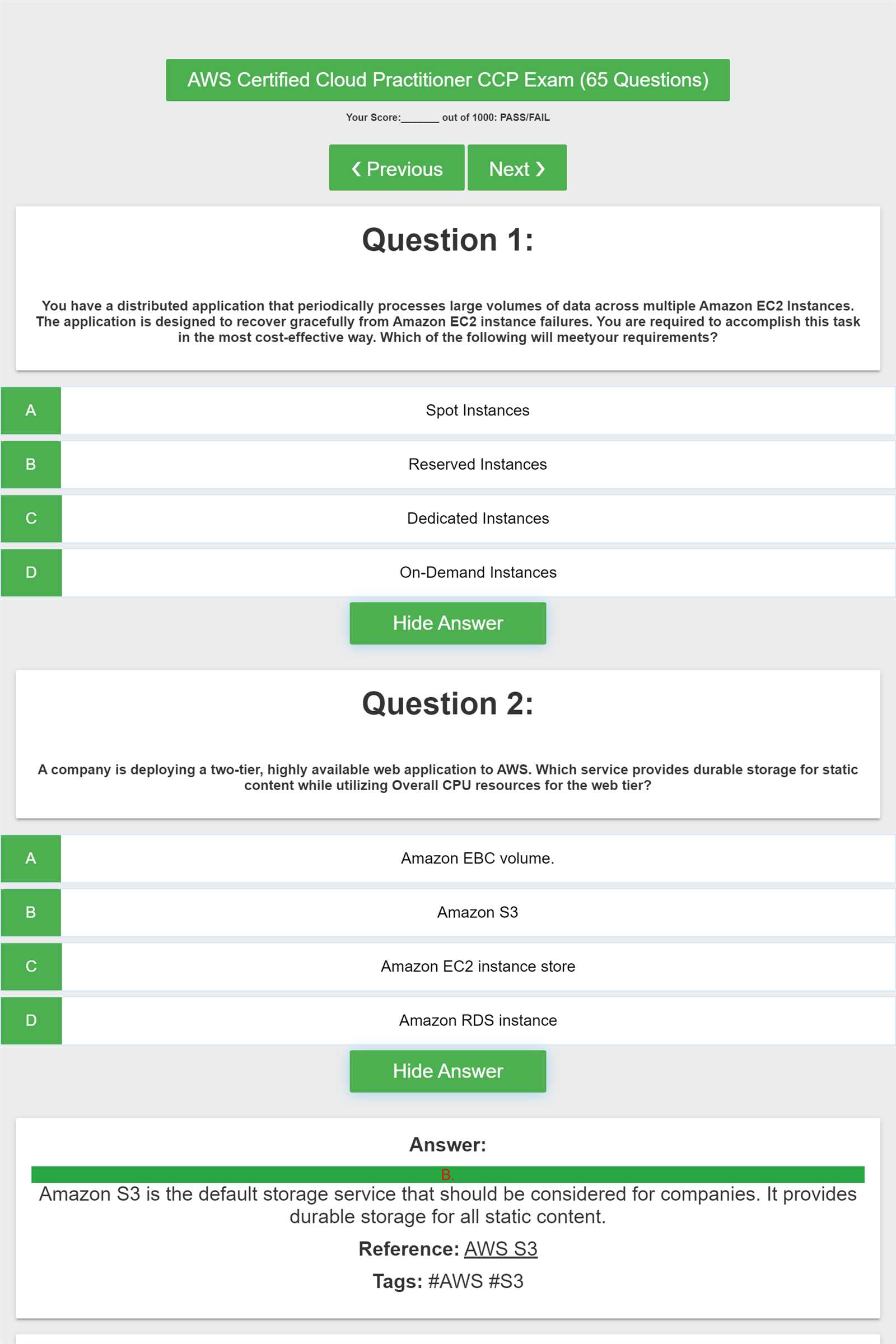
As you review sample questions, take time to not only identify the correct answers but also to understand why the other options are incorrect. This will deepen your comprehension of the material and prepare you for similar questions on the actual exam. Additionally, practicing with a variety of question formats will enhance your ability to quickly recognize key concepts and avoid common pitfalls.
How to Interpret AWS Documentation for the Exam
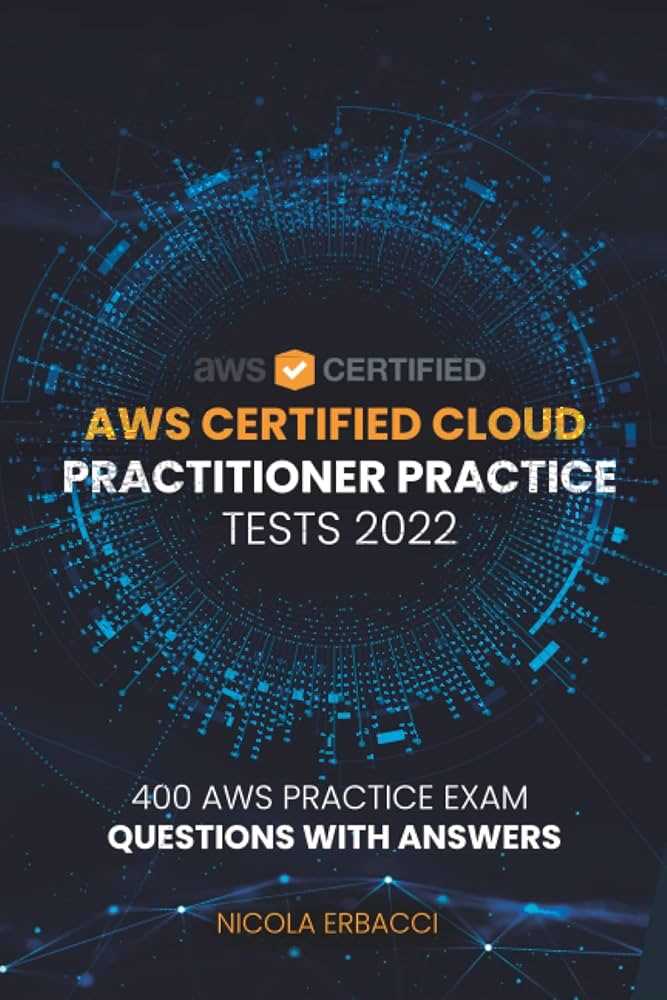
Understanding how to effectively navigate and interpret AWS documentation is a crucial skill when preparing for any certification exam. The official documentation provides in-depth details about various services, features, and best practices. Knowing how to quickly find the relevant information and comprehend complex concepts can help you answer questions confidently during the exam. In this section, we’ll explore strategies for leveraging AWS documentation efficiently while studying for your certification.
Focusing on Key Sections
AWS documentation is extensive, covering a wide range of topics. It can be overwhelming at first, but with the right approach, you can focus on the most important areas that are relevant to the exam. The documentation is typically organized into the following sections:
| Section | Description |
|---|---|
| Overview | Provides a high-level introduction to the service or feature, which is essential for understanding its purpose and core functionality. |
| Use Cases | Describes common scenarios where the service or feature can be applied, helping you relate the concepts to real-world situations. |
| Pricing | Details the cost structure associated with the service, important for understanding billing considerations and cost optimization. |
| Best Practices | Outlines recommended approaches to ensure security, performance, and efficiency when using the service. |
| API Reference | Contains detailed information about the API calls, syntax, and parameters; useful for deeper technical understanding but not as crucial for the exam. |
When studying for your exam, focus on the “Overview” and “Use Cases” sections as these provide the foundational knowledge that is commonly tested. The “Best Practices” section is also important, as it often highlights key concepts related to security, performance, and architecture, which are essential for passing the exam.
How to Read Documentation Efficiently

While the AWS documentation is detailed, it is not always necessary to read every single word. Here are some strategies to help you extract the most relevant information:
- Scan for Keywords: Start by scanning for keywords or topics that match the question types you expect to encounter. Look for definitions, advantages, and descriptions of AWS services and features.
- Focus on Examples: Many service pages include examples of how the service is used in real-world scenarios. These can provide practical insights into how the service works.
- Take Notes: As you read through the documentation, jot down key points or concepts that seem important. Use these notes to create study aids like flashcards or summary sheets.
- Use Search Features: AWS documentation often includes a search function that allows you to quickly find specific terms or services. This can save you time during both your studies and the exam.
By mastering how to read and interpret AWS documentation effectively, you can deepen your understanding of the concepts that are most likely to appear on the exam and build confidence in your preparation. This will not only help you pass the exam but also enhance your ability to apply AWS services in real-world situations.
Resources for Passing the AWS Cloud Exam
Preparing for the AWS Cloud certification exam can be an overwhelming task without the right resources. Fortunately, there is a wide range of study materials available to help you effectively learn and master the necessary concepts. From official AWS training courses to community-driven resources, utilizing a variety of tools can give you a comprehensive understanding of cloud services and ensure you’re ready for the exam. This section highlights some of the best resources to aid in your preparation.
Official AWS Training and Resources
The most authoritative source for exam preparation is AWS itself. Amazon offers a variety of official training courses and study materials designed specifically for their certifications. These resources cover the exam blueprint, key services, and best practices, making them a reliable foundation for your studies.
- AWS Training and Certification: AWS offers both free and paid training options, including instructor-led courses, digital training, and certifications paths. Their platform provides modules tailored for beginners and advanced learners alike.
- AWS Whitepapers and Documentation: AWS whitepapers are detailed resources that discuss best practices, security guidelines, and architectural frameworks. Reviewing these whitepapers will deepen your understanding of AWS services and help you apply concepts effectively.
- AWS Exam Readiness Videos: AWS provides free exam readiness videos which focus on specific certifications, helping you understand exam objectives and structure. These videos are ideal for visual learners and provide a structured overview of exam topics.
Third-Party Study Guides and Practice Exams
In addition to official AWS resources, third-party study guides and practice exams can help you gauge your knowledge and identify areas for improvement. These resources are often structured in a way that mirrors the actual exam format, allowing you to familiarize yourself with the types of questions you will face.
- Practice Exams: Websites like Whizlabs, ExamPro, and A Cloud Guru offer practice exams designed to simulate the real test environment. These practice exams are an excellent way to assess your readiness and build exam-taking stamina.
- Study Guides: Books like “AWS Certified Cloud Practitioner Study Guide” by Ben Piper or “AWS Certified Cloud Practitioner All-in-One Exam Guide” by Neal Davis are comprehensive resources that cover all exam objectives in-depth. These guides provide both theoretical knowledge and practical examples.
- Online Forums and Communities: Engaging with online communities such as Reddit, Stack Overflow, or LinkedIn groups can provide valuable insights and answers to specific questions you may have during your study process. Community members often share their exam experiences, tips, and study strategies.
Using a combination of official AWS resources and third-party tools will give you a well-rounded understanding of the topics and ensure you’re well-prepared for the certification exam. By tapping into multiple resources, you can approach the exam with confidence and increase your chances of success.